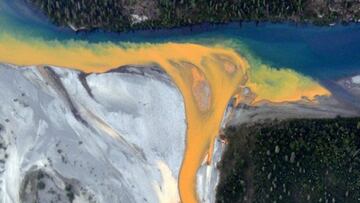Why are rivers in Alaska turning orange?
Streams and rivers in Alaska have been turning orange and changes in the environment may have something to do with this, according to scientists.

Dozens of streams and rivers are changing color in Alaska, going from crystal blue to orange. To figure out what was causing this, scientists from the National Park Service, the U.S. Geological Survey, the University of California and other institutions have studied and sampled the waters of 75 locations in an area the size of Texas in the Brooks Range in northern Alaska.
After years of research, they have come to some conclusions, and the results have been shared in the nature journal “Communications Earth & Environment”.
Using remote sensing, researchers discovered that warming in the environment could cause permafrost to thaw, generating an increase in the amount of iron and toxic metals in its waters. As they explain, “thawing permafrost can promote chemical weathering of minerals, microbial reduction of soil iron, and groundwater transport of metals to streams.”
This would mean that the affected rivers and streams would be literally rusting. This phenomenon, aggravated by climate change, could generate negative consequences on the environment, drinking water and fishing in the Arctic basins, according to experts. The Arctic area is warming almost four times faster than the rest of the world.
READ ALSO: Disaster declaration expands in Texas after major tornado touches down
Now THIS, is Wetlands Month art.
— U.S. Fish and Wildlife Service (@USFWS) May 22, 2024
Alaska's Tetlin National Wildlife Refuge is nestled within the Upper Tanana River Valley. The refuge has abundant wetlands & forests that welcome thousands of birds and people crossing the border into the state each year.#AmericanWetlandsMonth pic.twitter.com/ntFMCT6iih
“The more we flew, we began to notice more and more orange rivers and streams,” said the lead author of the research, Jon O’Donnell.
“There are certain places that look almost like milky orange juice. Those orange streams can be problematic in terms of being toxic, but they could also prevent fish from migrating to spawning areas.”
It was in 2018 when the researcher first became aware of the problem, when he observed that a river appeared rusty, even though it had been cleaned the previous year. After that, he began to investigate by accessing different remote parts, where helicopters are generally the only access route, to collect water samples from rivers and streams.
Assistant professor of environmental toxicology at UC Davis, Brett Poulin, said that in order to observe these color changes from space “you have to dye them a lot”. Based on his experience, he believes this phenomenon was similar to what happens with acid mine drainage. However, there are no fences near the contaminated rivers.
READ ALSO: What is ‘Tornado Alley’ and which states are in it?
Permafrost: the main factor
The affected rivers and streams are on federal lands managed by the Bureau of Land Management, the Fish and Wildlife Service and the NPS, including Gates of the Arctic and Kobuk Valley national parks. One of the main hypotheses is that as the climate warmed, the permafrost thawed, releasing the stored minerals, becoming exposed to water and oxygen, which generated the release of metals and acid. “Chemistry tells us that minerals are eroding,” says Poulin, who adds, “understanding what is in the water is a fingerprint of what happened.”
The study was carried out by taking samples in different months of the year. The results of the samples astonished the researchers, who found that some of them registered only a pH of 2.3 instead of the average of eight for these rivers.
According to the researchers, this means that the sulfide minerals are eroding, creating highly acidic and corrosive conditions and eventually causing additional metals to be released. Some of the metals of which unusual or elevated levels have been collected are iron, nickel, copper, cadmium and/or zinc.
“One of the most dominant metals is iron. That’s what causes the color change,” said the researchers. Another conclusion they reached is that although researchers noticed the change in 2018, satellite images would demonstrate that stained waters had already existed since 2008.
Possible consequences
For now, the researchers continue with their project, which has already been going on for two years under a three-year grant. The study aims to understand the reason behind this phenomenon, and evaluate its possible consequences for drinking water and its environment.
Related stories
“There are many implications,” according to O’Donnell, who points out that as climate change continues to aggravate them, “there is a possibility that streams could turn orange and degrade in terms of water quality.”
The majority of nearby communities depend on these rivers for drinking water. Changes in the water could also affect their food supply because the water could have an impact on the fish populations that feed nearby communities.


Complete your personal details to comment